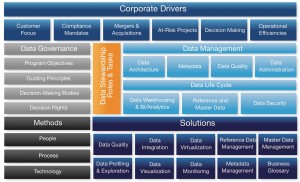21st century is the era of information revolution, when mass exploitation of data is a part of daily routine. Nowadays any business requires that the information driving the decision-making process be of a high quality, timely delivered and, above all, reliable and that it ensure security of the activity conducted. The development of analytics eco-systems, innovative products and services offered by companies has been based on the possibility of data gathering, processing and delivery.
The idea of Data Governance has been present in business for years. Due to the growing role of information in the governance process, data has become an asset for the company, just as significant as finance or human resources. Data requires a reliable approach to its processing, transparent governance, defined responsibilities, specified standards and principles of its administration, security and protection as well as monitoring and control. This broad scope of tasks related to managing data in an organization has been defined as Data Governance.
Methodologies and models
Effective development of principles of cooperation in an organization, in order to properly manage information and its circulation, requires using the best practices and the right models. Each organization, depending on the level of its maturity and business objectives, must find its own way; however, the use of models and frameworks for defining processes, roles and responsibilities guarantees that the developed Data Governance policy will be complete, at the same time facilitating and shortening the process.
Similarly to selecting project management methodologies, here we can also use highly ordered approaches focused on actions in pre-defined processes (e. g. Data Management Body of Knowledge – DAMA-BOK – created by DAMA International). We can look for Data Governance frameworks constructed in a manner which simplifies gradual construction of policies and strategies of data management in an organization as well. One of such guides is SAS Data Governance Framework, which indicates the key areas that should be covered by policies and procedures. It also identifies the roles directly related to the execution of the adopted principles of Data Governance.

A new, very significant role which is worth paying attention to is Data Stewardship, i. e. defining and identifying the persons responsible for data, the so-called data owners in the organization. Effective creation of attitudes and tasks for Data Stewards should allow them to fulfill the following tasks:
- data definition management, starting from their business meaning through defining structures and attributes determining business objects and acceptable scopes of their values
- creation and implementation of policies and procedures related to the management and reconciliation of changes in data definitions and changes in IT systems processing the data
- developing principles of data quality management owned by them, monitoring the quality of such data and fulfilling the tasks related to enhancing its quality (including conflict reconciliation and sometimes manual correction of the data)
- supporting proper and effective data use by the organization and cooperation
Proper functioning of Data Stewards environment is a cornerstone of effective implementation of Data Governance principles in an organization. It is them who are responsible for operational achievement of the objectives set for Data Governance programme.
In the digital era, this task must face additional challenges resulting from the popularization of Big Data environments. The striving for order and control clashes with immense changeability of the data processed by the organization as well as constant experimentation with new sources and changes in using the information obtained this way. Those two worlds collide regularly and applying Data Governance policies to Big Data environments must be based on a rational approach. Guidelines for an effective conduct of this process can be found on SAS blog: Can Big Data be governed? and Is effective Data Governance possible in an era of Big Data?.
Step “zero”: where to start?
The first step is to identify business objectives which the organization wants to achieve through Data Governance tasks execution. Gains may be sought in the following areas:
- enhancing the quality of data-driven decisions (confidence and trust in data and its sources)
- implementation of the regulator’s requirements with regard to the principles of data governance (e. g. recommendation “D” for financial institutions in Poland)
- supporting marketing and sale strategies by means of high quality of the customer data processed (higher effectiveness of marketing activities and the possibility of building a customer-oriented organization)
- optimization of the costs of maintenance and development of data processing environments thanks to the understanding of its flow and meaning for the organization.
Regarding the objectives, it is important to properly identify the persons responsible for subsequent tasks related to Data Governance programme and undertake the first initiatives in the environment defined this way.
Short-term gains can be obtained through three simple steps described below. Each step, implemented in the right sequence, gradually introduces the organization into the information governance culture, at the same time bringing measurable business benefits.
Read the following entries where the next steps of starting Data Governance initiative in an organization are discussed.

2 Comments
Pingback: Data Governance - first steps - part 3 of 4 - Bright Data
Pingback: Data Governance – first steps – part 4 of 4 - Bright Data